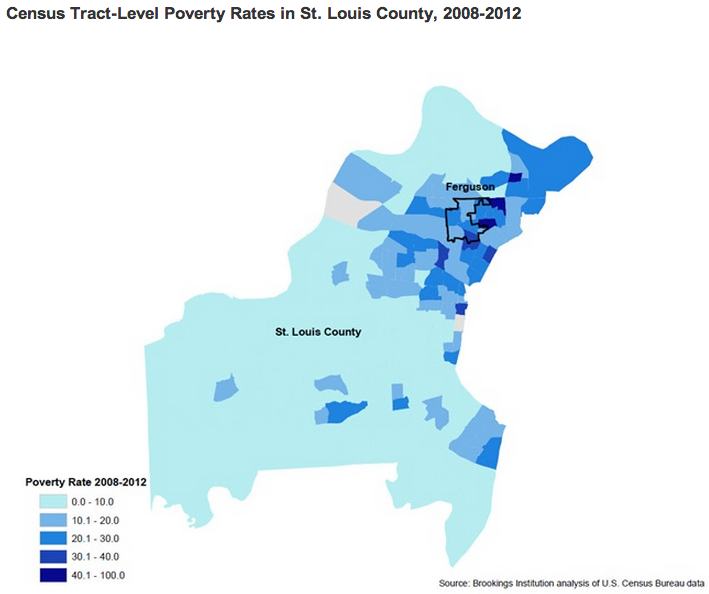
Ferguson, Missouri — which was engulfed in turmoil this week after Michael Brown's killing — suffers from deep racial divides, which pervade the city's police practices. But it turns out the St. Louis suburb also suffers from significant economic stress.
In a report issued Friday, The Brookings Institute characterized Ferguson as "emblematic of growing suburban poverty." The take away from the report isn't just that parts of Ferguson are poor, it's that they're newly poor.
Poverty rates in Ferguson have exploded in the last 14 years.
"Ferguson's poor population doubled," Brookings notes, and today nearly one in four residents of the city lives below the poverty level. By comparison, only 15% of all Missourians are poor, according to the U.S. Census. Broken down by census track, poverty rates in Ferguson range between 13.1% and 33.3%. That means that in the hardest hit parts of the city, about a third of the people are living in poverty.
In 2000, however, things looked very different. According to Brookings, at that time poverty rates ranged between 4% and 16% in Ferguson's neighborhoods.
This map shows Ferguson in 2000. The lighter the blue, the lower the poverty rate.

And this is Ferguson again, but using data from 2008 to 2012.

Unemployment in Ferguson nearly tripled over the last decade.
In 2000, Ferguson's unemployment was less than 5%, according to Brookings. But from 2010 to 2012, employment climbed to a crippling 13%. The report also notes that after adjusting for inflation, wages in Ferguson dropped. At the same time, the number of people using federal housing vouchers climbed from 300 in 2000 to 800 a decade later.
Changes like these can have dire consequence for communities.
Poverty in America is not new, but Ferguson is significant because it's a suburb, rather than an inner-city that might have historically or stereotypically been associated with these problems.
Suburbanized poverty can spell trouble for cities like Ferguson, which end up with inadequate access to resources, according to Brookings. Ferguson also may have suffered from negative effects of concentrated poverty, which begin to show up when a neighborhood reaches a poverty rate of about 20%. Other problems that arise in cities with problems like those Ferguson is facing include poor education and health, as well as rising crime rates.
The report also notes that cities facing this kind of economic stress can face another especially troubling challenge: violence.
